 |
Singapore: Contract Sweeping Keyed Toward Environmental Cleanliness
by Ranger Kidwell-Rossfrom an interview with Tan King Bok
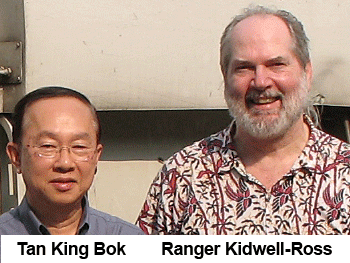
Tan King Bok is Vice President of Customer Relations Management and Government Relations of SembCorp Environmental Management Pte Ltd (SembEnviro). This is the contracting company that handles pavement cleaning as well as a variety of other, related tasks for two of Singapore's three street cleansing sectors. I found him to be most gracious -- especially since, because of a time-line misunderstanding, he had actually expected me to be there the day before.
Tan was formerly the Assistant Commissioner of Public Health in the then Ministry of the Environment in Singapore. As a result of this broad experience, he was completely knowledgable about his company's role in sweeping and performing other, related, services throughout two-thirds of Singapore. The following is the result of my interview with him, interspersed with images from his PowerPoint presentation and photos taken onsite at his SembEnviro location.
In terms of sweeping, Singapore is divided into three cleansing sectors, comprising Central, Eastern and Western sectors. The Eastern and Western sectors are contracted out to SembEnviro by Singapore's National Environment Agency (NEA), while the Central sector is contracted out to a French-based company, FME Onyx.
In the Western sector, SembEnviro provides the cleansing services for all expressways, roads, pavements, drains and other public areas, except those in 15 private residential estates which are termed by NEA as 'enclaves.' The enclaves are cleansed by NEA's own daily-rated employees (DREs), which are comprised mostly of employees who worked at those types of jobs for NEA prior to the start of contracting.
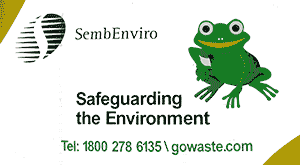
In the Eastern sector, SembEnviro provides cleansing services for all roads, except for expressways. These are maintained by the contractor for the Central sector. In regard to other pavement surfaces, drains and other public areas, SembEnviro also provides the cleansing services for certain areas called 'special cleansing areas.' Eastern sector portions outside the special cleansing areas are also maintained by DREs.
In addition to sweeping the streets and other pavement areas in SembEnviro's contracted area, the company also is charged with cleaning grassy and other areas along roadsides, scupper holes and other roadside drains, and bus shelters. In addition, the company handles the emptying and rebagging of the public litter bins.
The reach of SembEnviro into other environmental sectors includes garbage collection and recycling of plastics, paper, construction and demolition waste and more. Beyond Singapore, SembEnviro operates in several other countries in the Asian sector, including China and India. Part of the company's success no doubt stems from the ability of its senior management team, which includes some former senior officials from Singapore's public sector and elsewhere. SembEnviro employs about 2,600 people in its Singapore operations.
Both SembEnviro and Singapore in general are extremely pro-active about recycling. As of 2006 the country's recycling rate, according to figures compiled by the national government, was 51% of the total waste stream. The country has set its recycling target to be 60% by 2012 under its 10-year national 'Singapore Green Plan 2012' launched in 2002.
Pavement in the most sensitive areas of the country, and where there are the highest number of people, are swept daily. Some areas in the central business district are maintained continually, perhaps even re-visited on an hourly basis. On average, most areas are cleaned two or three times a week. Outlying areas may be cleaned as infrequently as only once weekly.
One somewhat unusual program for SembEnviro is that it is in charge of supplying pre-paid garbage bags to government (NEA) workers. These are sold for a little over S$1 apiece; they are that expensive because the price includes the disposal cost per bag. Because disposal costs are pre-paid, the company can know it's being paid when it picks up and disposes of the bags wherever they are located once full.
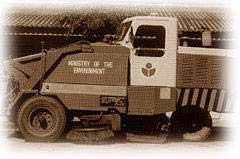
The then Ministry of the Environment in Singapore got its first mechanical sweeper, the broom machine shown, in 1974. Having now learned about the superior small-micron cleaning ability of air sweepers, SembEnviro now prefers regenerative air-based sweepers, since these have an air blower in addition to a suction component. Of course, in the tropics spring cleanup is not a factor.
Although SembEnviro employs about 300 manual cleansing personnel, the majority of roadways are swept by a variety of different makes and models of sweepers. The full-size models the company currently has includes the Johnston models 5000 and 600, and the Australian-built Schwarze A6500XL.
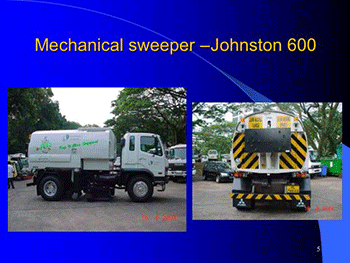
The smaller sweepers, like the Johnson 5000 shown, are especially useful in residential estates where the roads are quite narrow. In Singapore, like in most of Asia and Europe, these types of areas usually have many cars that have to be maneuvered around. For other pavement sweeping the Karcher and Green Machines are used. The downside of these latter two sweeper types is they can't travel very fast between jobs.
Finally, SembEnviro employs some all-terrain litter vacuum machines that go off-pavement for otherwise hard-to-reach areas. These are small sweepers that can pick up on rougher surfaces, including turfed areas.
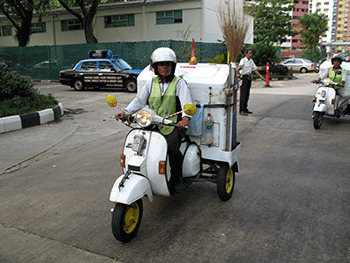
The company also uses a local invention, which is a scooter tricycle, to transport some of the manual cleansing personnel. In addition to having a debris receptacle, the scooter has a place on the back for the workers to carry their brooms, dustpan and so forth. The trikes are mostly used for transporting cleansing workers from bus stop to bus stop. It is a type of transportation that can carry all an operator needs, plus which is easy to drive and inexpensive to operate.
Some of the bus stops are quite large and can contain a fair amount of debris. Although the debris at a typical bus stop won't completely fill the litter container, the riders don't want to be transporting much extra weight on these little machines. So, after each cleaning stop, the operators drop off the bagged contents of their litter container at a spot where it can be picked up by one of the company's trash bag collection vehicles.
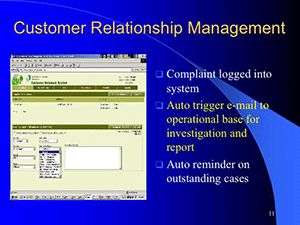
As an aid to providing excellent service, SembEnviro employs a sophisticated Customer Relationship Management software system. When any complaints come in, they are logged into the company-wide computer system.
This automatically triggers an email that's sent to the local base management team for whatever area of the company the complaint is about. I.e., garbage pickup complaints go to that manager, sweeping goes to the sweeping manager for the appropriate sector, etc.
It is then that manager's duty to investigate the complaint, after which they enter their report into the system. The software includes an automatic reminder when any cases stay outstanding past when they should be settled. Every morning at 10am, with the promptness only computers can provide, these outstanding complaints come up in the company's central management computer so they can stay on top of getting them resolved.
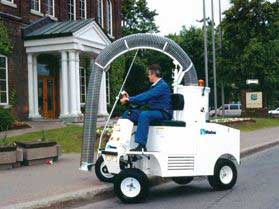 Allianz (formerly Johnston) is the world's largest manufacturer and distributor of street sweepers.
Allianz (formerly Johnston) is the world's largest manufacturer and distributor of street sweepers.
The Madvac 101 is expertly designed to meet the cleaning challenges of today's busy streets. Its all-wheel drive, strong suction and 120 gallon capacity hopper combine to make the Madvac 101 into a cost-efficient cleaning machine that safely and effectively cleans city sidewalks and parks. It is also an efficient parking lot vacuum machine that has the ability to reach into otherwise confined places. With the Madvac 101 you can safely vacuum-collect next to pedestrians, allowing cleanup of litter as it occurs. The MadVac 101 allows you to shows citizens and local businesses how serious you are about improving their environment. We make the Madvac 101 available in custom colors and graphics in order for you to better advertise your efforts. We invite you to click here or on the photo for more information. |

SembEnviro's entire vehicle fleet is equipped with GPS transponders. This provides the company's managers with detailed knowledge about where their vehicles are at any particular time.
Juliana Heng, a senior customer relations executive in SembEnviro's call center, offered an explanation of how SembEnviro's GPS system worked. Tracking is done on almost all of SembEnviro's scheduled route vehicles, including sweepers and garbage trucks. The company's GPS call center has a group of three computer monitors that allow individual access to the company's vehicle data. In addition, any of the route information may be projected onto the center's large, almost wall-width screen.
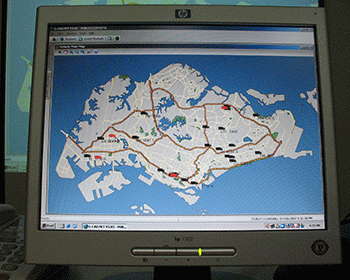
Their software allows vehicle tracking either from a distance or extremely close-up. The data is most often used for verifying vehicle locations in the cases of a complaint being lodged by a citizen. In those instances, the data can be proof positive whether or not a particular SembEnviro vehicle was even in the vicinity at the time alleged. It also allows feedback to the crews on whatever factors are tracked on that particular type of vehicle.
The company tracks speed, stops, and any other data it chooses. A variety of reports are available. The system has been online for between two and three years. Unlike what is so often reported with U.S. contractors, Heng was unable to recall any instances in which an employee was involved in any type of illicit behavior with their sweeper or other vehicle. Mostly, she said, it is used for confirmation of past events whenever a complaint is lodged.
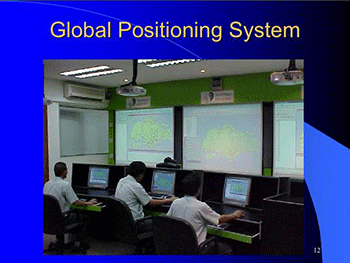
In those instances, the management team analyzes driver speed and any other pertinent factors in order to make a determination. Then, a factual report may be made back to the citizen. The actual reports are not shared with those who might complain, however.
By contract, SembEnviro is required to respond to emergencies, like a spill of earth or mud along a road, within an hour's time. The GPS is also helpful for confirming response times from when an alert is received, to show contract compliance.
Also, because the company's GPS system involves a large number of vehicles that are typically spread throughout much of the country, the system also figures into Singapore's national emergency planning scheme. In the event of a natural or other disaster, SembEnviro's call center -- with its GPS-enabled capability -- could double up as a command center for SembEnviro to become an integral part of a nationwide response and tracking system.
In Singapore, two levels of training are provided for street cleansing personnel. One of these is the standard on-the-job type most people are familiar with. When a worker comes in he is given training about the company, his job, how to operate his machine, how to get from point 'A' to point 'B' and so forth. To start with, he is provided with a map that shows the route he is to take while doing his job, and whatever else he needs in the way of hands-on help to be able to do it.
The country also has a national job training program, called the National Skills Recognition System (NSRS). This training scheme offers a national standard of certification, which is imposed by the government onto many of the contractors that do work for them. For example, in the case of street cleansing, 100% of the supervisors and operators of mechanical road sweepers and pavement sweepers must be certified through NSRS. For manual cleansing personnel, and those who do litter picking and clean the drains, the required level is 50% of the workforce involved in such works.
After obtaining a government contract, the winning company is given a period of time in which they have to bring their workforce up to the required NSRS training standards. In the case of SembEnviro, this period was 18 months.
Although passage of the NSRS training is typically required for some portion of a contractor's workforce performing under a government contract, getting NSRS certification doesn't automatically lead to increases in pay for the workers, though it is a factor in that regard. Rather, pay increases are tied to job performance, work record and other factors -- in addition to successful completion of NSRS training. Taken together, these provide a competitive method of comparing different workers. Over time, this system is what results for an increase in pay for those who perform well.
Prior to heading out on their route, mechanical sweeper operators first have a checklist they fill out as they check over their machine. Then, they are provided with a route sheet that, although standard in other regards, has at least one factor I haven't seen in the U.S. or elsewhere before.
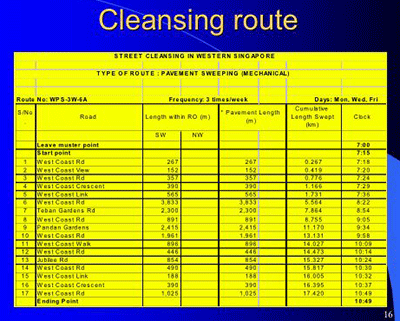
As you can see in the graphic, the route sheet not only includes the length of each section of road, but also the time at when the operator 'should' be sweeping that particular section of pavement. How well an operator was keeping to schedule could, of course, be correlated by the GPS records. This is included, however, as a rough estimate that is dependent upon debris load, weather conditions, etc.
However, for any roadway that's swept often and so not subject to much variation in debris load, this type of information might prove helpful as a 'check-and-balance' for both the operators and for management. Management is also able to correlate profitability with actual time spent vs. scheduled time. This system certainly would not work where pavement is swept only every few weeks or longer, though.
Three-times-a-week routes are done either Monday/Wednesday/Friday or Tuesday/Thursday/Saturday. Mechanical sweeping is typically not done on Sundays except in areas swept daily.
Tan King Bok's excellent presentation also included a variety of information about the country's state-of-the-art recycling programs (virtually everyone gets doorway recycling once every two weeks), incineration and non-incinerable waste disposal programs (this material is now barged onto an island off Singapore's coast). However, since this didn't particular concern the sweeping industry, the information is not included in this article.
Overall, Singapore clearly has one of the world's leading sweeping programs. Unlike many countries – the U.S. immediately comes to mind – Singapore's leaders have clearly made a strong connection between correct street sweeping and the country's overall quality of cleanliness and citizen health.
No doubt this is somewhat driven by the relatively small surface area the country covers, as well as the fact that, as an island, it's pretty much a closed system. In other words, they realize that there is no downstream where anyone can send their waste -- and that such a solution only makes for a problem for the people downstream, in any event.
The overall coordination afforded by having the sweeping, garbage collection and related services all performed by the same entity also appeared to offer economies of efficiency, as well. Finally, by having the entire industry under the federal auspices of the National Environment Agency the oversight starts off on the right foot in the first place.
In all the places around the world that I've covered sweeping, including Europe, Australia and other parts of Asia, this program clearly ranks up near the top with Denmark. And, yes, Singapore's overall sweeping program appears to be even a bit more professional than the good job being done in Hong Kong.
Ranger Kidwell-Ross is editor of WorldSweeper.com, and the world's most prolific author on the topic of power sweeping. This story was written during his trip to Singapore and Thailand in 2007 to investigate how sweeping was done in those countries. If you have questions or comments on this story, or on any other aspect of the power sweeping industry, please let us know.
 |
© 2005 - 2021 World Sweeper
|
Countries Contents
|